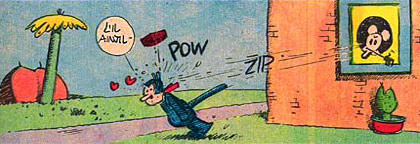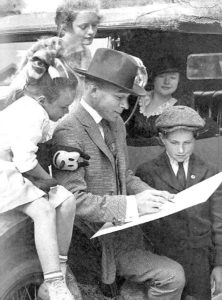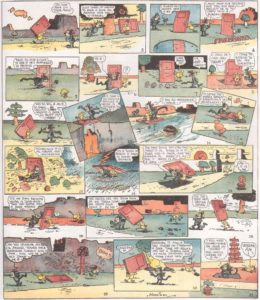August 22 in Comics History

George Herriman

Creator of the classic comic strip Krazy Kat, George Herriman (August 22, 1880 – April 25, 1944) began his career an illustrator, engraver, and political cartoonist for the Los Angeles Herald-Examiner. He produced several mediocre early comic strips, including Professor Otto and His Auto and Major Ozone, before developing his own unique style with Gooseberry Sprig and The Dingbat Family.
In The Dingbat Family, the human family and their foibles occupied most of the strip, but the bottom part of each panel contained an unrelated storyline featuring a cat and a mouse under the floorboards. That cat and mouse got their own strip in 1913, originally titled Krazy Kat and Ignatz, later shortened to simply Krazy Kat.
Krazy Kat appeared in Hearst newspapers from 1913 until 1944. Set in Coconino County, Arizona, the strip featured “offbeat surrealism, innocent playfulness, and poetic, idiosyncratic language” and has been a critical favorite for many years. The strip focuses on a love triangle involving Krazy Kat, whose gender is never specified, the obsessive Ignatz Mouse, and the protective police dog Offissa Bull Pupp. Krazy loves Ignatz, who throws bricks at Krazy’s head. Krazy interprets the bricks as signs of love, while Offissa Pupp tries to stop Ignatz and lock him in the county jail.
Fans of Krazy Kat included poet e. e. cummings, painter Willem De Kooning, columnist H. L. Mencken, and beat writer Jack Kerouac. In 1922, a jazz ballet based on the strip played to sold-out crowds. Numerous animated versions have been released, the earliest in 1916. A comic book drawn by John Stanley of Lulu fame recast Krazy Kat as a typical “funny animal” strip. Krazy Kat influenced Chuck Jones’ Road Runner, Bill Watterson’s Calvin and Hobbes, and many others. In 1995, Krazy Kat was one of 20 strips included in the US Postal Service Comic Strip Classics set of commemorative stamps.
Herriman himself was born in New Orleans to a Creole African-American family. The family moved to Los Angeles to avoid Jim Crow laws in Louisiana, and passed as white. Herriman’s newspaper colleagues thought his ancestry was Greek, and his death certificate lists his race as “Caucasian.” His wife and daughter both died in the 1930s, and Herriman lived alone with his cats and dogs until his death in 1944. His ashes were scattered by airplane over Monument Valley, Arizona.
